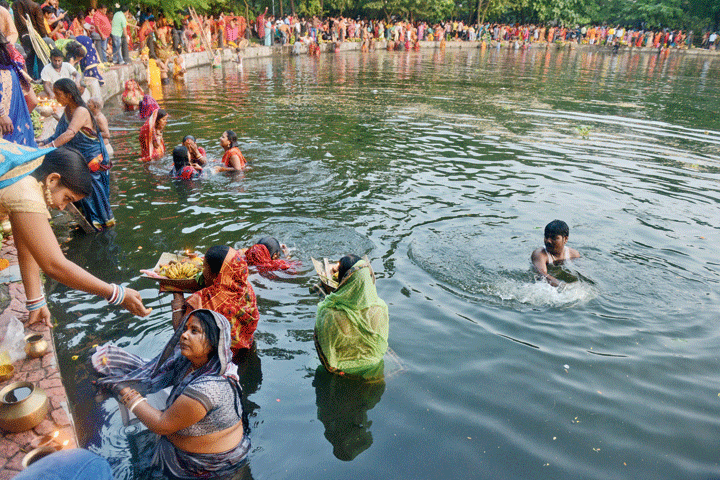With an administration more than willing to look the other way, thousands performed Chhath Puja at Rabindra Sarobar on Saturday, violating directives of the National Green Tribunal.
Countless people thronged Rabindra Sarobar from Saturday afternoon, damaging smaller patches of green after breaking the bamboo barricades around them. The devotees were also seen pouring ghee and oil in the water. Besides, flowers and leaves were found floating in the waters.
Some of them also burst crackers and the deafening sound of drum beating, though outside the gate, created a noise level that is prohibited in the park.
“Both the biological oxygen demand and dissolved oxygen levels are expected to get poorer and the aquatic flora and fauna could be affected because of what happened on Saturday,” said a scientist associated with the environment department.
Dissolved oxygen is a measure of the amount of oxygen dissolved in water. The oil and ghee poured in the water creates a layer on top that prevents the diffusion of oxygen into water from the atmosphere.
“This would lead to depletion of oxygen level in the water. Also the flowers and leaves that fell in the water would require oxygen to decompose. So from one side the addition of oxygen is getting reduced and also the demand for oxygen in the waters is rising,” said a zoology teacher of an undergraduate college of Calcutta University.
He said that fishes and all other insects living in the water need the dissolved oxygen to survive. Any imbalance in the dissolved oxygen could becomes fatal for them.
In winter, fishes are often found floating dead in the lake due to low dissolved oxygen. “The dissolved oxygen level normally drops in the absence of strong sunlight. As the Chhath rituals happen around sunrise and sunset, it adds to the impact,” the teacher said.
“The Sarobar water is quite polluted with various sources contributing to its high alkalinity and biological oxygen demand (BOD). It is expected to get worse after devotees in such large numbers performed Chhath rituals in the lake,” he added.
“As the NGT had completely barred Chhath rituals being performed in the lake, we did not keep any arrangement for devotees,” said an official of the Calcutta Metropolitan Development Authority (CMDA), which administers the Sarobar.
Environmentalists also said that high noise level could scare away birds. A very rich variety of birds are residents of the Sarobar’s trees and many migratory birds are known to visit the park during winter, from places far away.
In earlier years, when Chhath used to be observed legally in the Dhakuria lake, a barricade of 3ft was constructed from the bank to ensure that the flowers and other materials do not float into open water. Not did people encroach significantly into the water, they actually broke open wooden barricades at several places. The barricades protect the bank wall as well as the biodiversity around water.
“One has to keep in mind that the NGT had passed the order for stopping Chhath Puja at Rabindra Sarobar not suo moto but on basis of the recommendations of an expert committee that included senior experts from various state government departments,” said environmentalist Subhas Datta, who had petitioned to green tribunal about lake pollution along with others.
“During Chhath Puja, as reported, 40,000–50,000 people enter the Sarobar premises. This causes massive loss of biodiversity. Further the rituals pollute lake water with flowers, and also the soil is polluted … due to ghee, oil etc ; cracker bursting and emission of high intensity noise also greatly disturb biodiversity,” reads the report on the basis of which the regulatory order was passed by the NGT in 2018.
“The entire lake has been devastated environmentally,” said Sumita Banerjee, an environment activist working for the protection of Rabindra Sarobar’s biodiversity.
The environment impact assessment report of Rabindra Sarobar, a copy of which is with Metro, also points out that the lake water already has high BOD, rising as high as 13.5 milligram per litre against a desirable level of 2 milligrams. The alkalinity level and potassium were also found to be quite high. “When the pH of fresh water becomes highly alkaline (greater than 9), the effects on fish are lethal”, says report.










